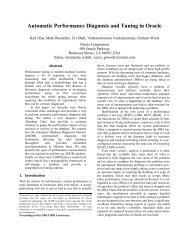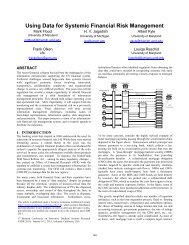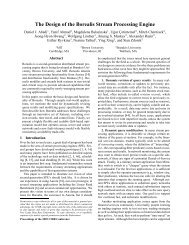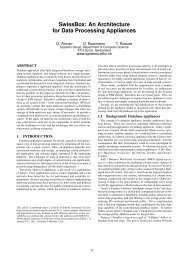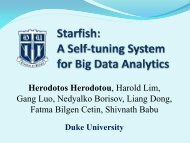Query Processing for Sensor Networks - CIDR
Query Processing for Sensor Networks - CIDR
Query Processing for Sensor Networks - CIDR
You also want an ePaper? Increase the reach of your titles
YUMPU automatically turns print PDFs into web optimized ePapers that Google loves.
There are two alternative plans <strong>for</strong> this query. We<br />
can create a flow block <strong>for</strong> each group, or we can create<br />
a flow block that is shared by multiple groups.<br />
To create a separate flow block can aggregate sensor<br />
records of the same group as soon as possible,<br />
shorten the path length, and allow to apply the predicate<br />
of the HAVING clause to the aggregate results earlier,<br />
which saves more communication if the selectivity<br />
of the predicate is low. The optimizer should take several<br />
parameters into account to make the best plan.<br />
One parameter is the overlap of the distribution of the<br />
physical locations of the sensors that belong to the different<br />
groups. If sensors that below to a single group<br />
are physically close, it is better to create a separate<br />
flow block to aggregate them together, since the communication<br />
cost to aggregate close-by sensors is usually<br />
low. However, if sensors from different groups are<br />
spatially interspersed, it is more efficient to construct<br />
a single flow block shared by all groups.<br />
Joins. The computation part of a flow block does<br />
not need to be an aggregate operator. It is possible to<br />
add join operators to our query template and define<br />
flow blocks with joins. Joins will be common in applications<br />
<strong>for</strong> tracking or object detection. For example,<br />
a user may pose a query to select all objects detected<br />
in both regions R1 and R2. The following query has a<br />
join operator to connect sensor detections in the two<br />
regions.<br />
(Q2) SELECT<br />
FROM<br />
WHERE<br />
oid<br />
<strong>Sensor</strong>Data D1, <strong>Sensor</strong>Data D2<br />
D1.loc IN R1 AND D2.loc IN R2<br />
AND D1.oid = D2.oid<br />
Join operators represent a wide range of possible<br />
data reductions. Depending on the selectivity of the<br />
join, it is possible to either reduce or increase the resulting<br />
data size. If the join increases the result size,<br />
it is more expensive to compute the join result at the<br />
leader instead of having the leader send out the tuples<br />
from the base relation. Relevant catalog data to<br />
make an in<strong>for</strong>med decision concerns the selectivity of<br />
the join and the location of the leader.<br />
6 Experimental Evaluation<br />
6.1 Experimental Setup<br />
We have started to implement a prototype of our query<br />
processing layer in the ns-2 network simulator [4]. Ns-2<br />
is a discrete event simulator targeted at simulating network<br />
protocols to highest fidelity. Due to the strong interaction<br />
between the network layer and our proposed<br />
query layer, we decided to simulate the network layer<br />
to a high degree of precision, including collisions at<br />
the MAC layer, and detailed energy models developed<br />
by the networking community. In our experiments, we<br />
used IEEE 802.11 as the MAC layer [36], setting the<br />
communication range of each sensor to 50m and assuming<br />
bi-directional links; this is the setup used in<br />
most other papers on wireless routing protocols and<br />
sensor networks in the networking community [14].<br />
In our energy model the receive power dissipation is<br />
395mW, and the transmit power dissipation is 660mW<br />
[14]. (This matches numbers from previous studies.)<br />
There are many existing power-saving protocols that<br />
can turn the radio to idle [35, 27], thus we do not take<br />
the energy consumption in the idle state into account.<br />
<strong>Sensor</strong> readings were modeled as 30 bytes tuples. 6<br />
6.2 Simple Aggregate <strong>Query</strong><br />
Let us first investigate experimentally the effects of innetwork<br />
aggregation. We run a simple aggregate query<br />
that computes the average sensor value over all sensor<br />
nodes every 10 seconds <strong>for</strong> 10 continuous rounds. <strong>Sensor</strong>s<br />
are randomly distributed in a query region with<br />
different size. The gateway node, which is located in<br />
the left-upper corner of the query region, is the leader<br />
of the aggregate query. Each experiment is the average<br />
of ten runs with randomly generated maps.<br />
We first investigate the effect of in-network aggregation<br />
on the average dissipated energy per node assuming<br />
a fixed density of sensor nodes throughout the<br />
network (in this experiment we set the average sensor<br />
node density to 8 sensors in a region of 100m × 100m).<br />
Figure 5 shows the effect of increasing the number<br />
of sensors on the average energy usage of each sensor.<br />
In the best case, every sensor only needs to send one<br />
merged data packet to the next hop in each round,<br />
no matter how many sensors are in the network. The<br />
packet merge curve increases slightly as intermediate<br />
packets get larger as the number of nodes grows. Without<br />
in-network aggregation, a node n has to send a<br />
data packet <strong>for</strong> each node whose route goes through<br />
n, so energy consumption increases very fast.<br />
We also investigated the effect of in-network aggregation<br />
on the delay of receiving the answer at the gateway<br />
node as shown in Figure 6. When the network size<br />
is very small, in-network aggregation introduces little<br />
extra delay due to synchronization, however as the network<br />
size increases, direct delivery induces much larger<br />
delay due to frequent conflicts of packets at the MAC<br />
layer.<br />
6.3 Routing<br />
To test the efficiency of our improved local repair algorithm,<br />
we ran a simple aggregate query which computes<br />
the average over all sensor readings every 10 seconds.<br />
In this experiment, 200 sensors are randomly<br />
distributed in a 500m*500m area. (For other experiments<br />
the numbers were qualitatively similar.) We<br />
6 See the discussion of future work in Section 8 <strong>for</strong> drawbacks<br />
of our current experimental setup.



